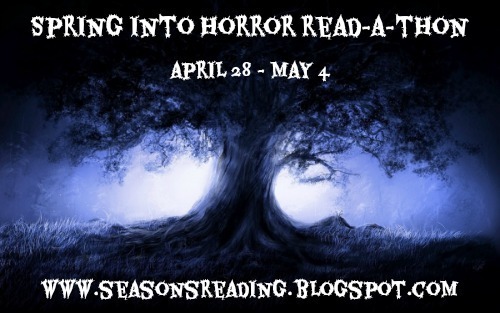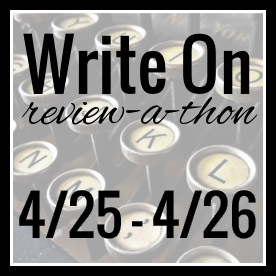Katherine Nabity's Blog, page 211
April 28, 2014
Spring Into Horror Read-a-Thon

Hosted by Michelle @ Seasons of Reading
The Spring into Horror Read-a-Thon is almost here! It’s coming to put some scare in your Spring on Monday, April 28 at 12:00am CST through Sunday, May 4 at 11:59pm CST (adjust times according to your time zone). Now don’t let the word ‘horror’ scare you away. You only have to read one scary book during the duration of the read-a-thon.
Possible Reads



The Best Horror of the Year, Volume Six edited by Ellen Datlow (an ARC)
Abra-Cadaver by Matt Drabble (from my Indie pile)
Alarums by Richard Laymon or The Haunt by J.N. Williamson (from my TBR pile)
Short Story: “The Man in the Woods” by Shirley Jackson (a previously unpublished story that’s currently available in The New Yorker)
Short Story: “The Barnum Museum” by Steven Millhauser for Deal Me In
No specific goal. Just aiming to get some reading done. :)
(‘Course, now that I’ve listed these I totally want to read everything else!)
Updates
Monday
Book:
# Pages Read:
# Pages Read Total:
Notes:


April 26, 2014
Deal Me In, Week 17 ~ “Eisenheim the Illusionist”
Hosted by Jay @ Bibliophilopolis
“Eisenheim the Illusionist” by Steven Millhauser
Card picked: Ten of Diamonds
From: The Barnum Museum
Review: (Or, rather, some history of me being a procrastinator.)
2006 was a good year for magician movies. Two premiered that year: The Prestige featuring a whole host of post-Batman Begins stars including Christian Bale, Michael Caine, and Christopher Nolan (directing), and The Illusionist with the ever low-key Edward Nortan and the incomparable Paul Giamatti. I saw both in the theater well before magic became a full-blown research project/hobby. I like them both, but The Illusionist has become my absolute favorite.* It’s a smaller, more real story. Many of its narrative beats harken back to the magician “biographies” I’ve read, fanciful tales of mysterious mentors met on a journey.
But I’m getting ahead of myself. Both are based on written works and I love reading movie source materials. I managed to nab a copy of The Prestige by Christopher Priest fairly easily from PaperbackSwap, but Millhauser is more…literary. With fewer copies available on the secondary market. I hemmed and hawed and finally purchased The Barnum Museum on December 21, 2011, presumably with birthday money. So eager was I to read “Eisenheim the Illusionist” that I didn’t get to it until June of 2012! (A few months later Eric would suggest that I might write a novel about an early 20th century magician. There’s been no looking back.) I read another of the stories in the collection and, well, wasn’t as impressed.
For Deal Me In, I figured I’d finally finish reading The Barnum Museum (a mere three years after I purchased it), but I also wanted to give “Eisenheim” a reread. I enjoyed it well enough when I first read it, but (according to the notice of it) I found it tiring. “Eisenheim the Illusionist” is less visual than the other Millhauser stories I’ve read. He includes the names of many classic tricks and alludes to a plethora of magic devices, but doesn’t go out of his way to describe them. I assume this is what I found tiring previously. On a reread, after a year and a half of becoming familiar with the jargon, I weirdly found the details exhilarating. Millhauser definitely knows some magic history and has infused the story with it. This story also feels more rounded and satisfying than the others of his I’ve read, even though it is much more narratively loose than the movie. As I often say when discussing books to movies, both are good in their own way.
* Depending on the day of the week, The Prestige and last year’s Now You See Me vie for second place. Fourth is occupied by a rather fictitious Houdini pic called Death Defying Acts (2007). In fifth place is The Brothers Bloom (2008), which doesn’t feature a magician, but has a plot so filled with cons and misdirections that it’s more of a magic story than many of the tales in the Copperfield anthologies I’ve been reading. It also features voice over by Ricky Jay, which makes it a magical half-cousin at least. Jay was also an advisor on The Prestige and The Illusionist, appearing in the former.


April 24, 2014
Thoughtful Thursday: Reading a Series from Start to Finish

Hosted by Pamela @ Reading is Fun Again
This Thursday’s question:
Assuming that you are late to the party with a book series (and the entire series is completed) and you want to read every piece of text within a series’ universe that you can get your hands on, in what order to you read the books, short stories, and novellas within the universe? Do you read the books first and then the short stories and novellas if you want more? Do you read the books, short stories, and novellas in order (either publication or chronological)? Do you read them in some other order?
Well, we’ve already established that I’m pretty crap at reading series. ;) Honestly, I’m a little befuddled by the trend of having short stories and novellas as part of a series, although I suppose I shouldn’t be. I’ve been reading within certain fandoms (Star Wars, Star Trek, Doctor Who etc.) for most of my reading life. In the case of those “series,” story chronology has never seemed very important, probably because there are many writers involved in creating the world instead of just one. The Song of Ice and Fire read-through included a couple of Martin’s shorter works set within Westeros, but I sort of ignored them even though I think I have one of the stories around here in a Legends anthology. I suppose, I’d probably read in order of publication. As a writer, I know how hard it is to keep author knowledge out of plot, and I’d probably count on some “insider” knowledge being helpful if I was reading a prequel that was written after several books in a series. (Speaking of fandoms, a question that keeps popping up among friends who have children is, what order do you show your kids the Star Wars films? I can’t really imagine seeing those movies in the plot chronology order.)


April 23, 2014
Write On Review-a-Thon 3
The Write On review-a-thon is a monthly event created and hosted by Brianna at The Book Vixen. It’s 2 days dedicated to getting reviews done, whether you have one review to write or 30+. This edition of the review-a-thon takes place all day Friday, April 25th and Saturday, April 26th. Let’s get those reviews done!
Once again, I’m not too behind, but I wouldn’t mind getting ahead. Here’s the slate:
Tesla: Inventor of the Electrical Age by W. Bernard Carlson (A double review with Nikola Tesla: Imagination and the Man That Invented the 20th Century by Sean Patrick)
Glorious by Jeff Guinn (Alas, a DNF, but I’m still going to write it up.)
Deal Me In post for “Eisenheim the Illusionist”
Set up for A Feast of Crows and The Best Horror of the Year, Volume Six


April 22, 2014
Review ~ The Silver Linings Playbook
An enchanting first novel about love, madness, and Kenny G.
During the years he spends in a neural health facility, Pat Peoples formulates a theory about silver linings: he believes his life is a movie produced by God, his mission is to become physically fit and emotionally supportive, and his happy ending will be the return of his estranged wife, Nikki. When Pat goes to live with his parents, everything seems changed: no one will talk to him about Nikki; his old friends are saddled with families; the Philadelphia Eagles keep losing, making his father moody; and his new therapist seems to be recommending adultery as a form of therapy.
When Pat meets the tragically widowed and clinically depressed Tiffany, she offers to act as a liaison between him and his wife, if only he will give up watching football, agree to perform in this year’s Dance Away Depression competition, and promise not to tell anyone about their “contract.” All the while, Pat keeps searching for his silver lining. In this brilliantly written debut novel, Matthew Quick takes us inside Pat’s mind, deftly showing us the world from his distorted yet endearing perspective. The result is a touching and funny story that helps us look at both depression and love in a wonderfully refreshing way. (via Goodreads)
I watched the movie based on this book back around when the movie was nominated for several Oscars. The movie is pretty quirky and I wondered what the book was like, especially since the movie culminates with a dance routine. I’m always interested in how action scenes of every kind are written.
This book is equally as quirky, though the story is a little different. It’s, well, less cinematic. The conflicts that make for a good movie aren’t as necessary in a novel, especially when the novel is a first person narrative about a man coming to terms with his past, both his actions and the actions of others. There is also perhaps more leeway in written fiction for coincidences, especially with the main character is as befuddled by them as the audience might be. I didn’t realize this was Matthew Quick’s debut. In The Silver Linings Playbook, he manages to write about some weighty subjects with a very light hand. (David O. Russell did a really good job with the screenplay as well. He was beat out for the adapted screenplay Oscar by Chris Terrio’s Argo. I have to believe that Russell was a close second.)
So, how does one write a dance scene? In the book, the dance is not as much of a climactic moment, so there is a certain vagueness to the actions. Funnily enough, the opposite is true of the dance training. Since the character of Pat has decided his life is a movie, he gives us a “montage” of his training, instead of the more separate scenes that exist in the movie. The differences between the book and movie are pretty interesting.
Publisher: First published by Farrar, Straus and Giroux
Publication date: 2008
Genre: Literary
Why did I choose to read this book? Curiosity


April 21, 2014
It’s Monday! What am I Reading? (4/21/14)
 Hosted by Sheila at Book Journey
Hosted by Sheila at Book Journey
It’s Monday! What Are You Reading is where we share what we read this past week, what we hope to read this week…. and anything in between! This is a great way to plan out your reading week and see what others are currently reading as well… you never know where that next “must read” book will come from!
Happy Monday Everyone!
 Reading
ReadingThis week’s reading looks a lot like last week’s reading: Jeff Guinn’s Glorious (an ARC) and Briar Rose by Jane Yolen (for the Once Upon a Time Challenge). I finished one Tesla book and am now reading Sean Patrick’s Nikola Tesla: Imagination and the Man That Invented the 20th Century, which seems to be more about a theory of genius than about Mr. Telsa. Mainly reading it because it was a freebie and I figured it would round out my bunch of Tesla books.
Arrivals
None! But I do have a couple requests pending.
On the Blog / Bloggish Things
Busy week, and I’m not even doing Dewey’s! (Seriously, I’m tempted, but I already have a bunch of stuff going on including an entire afternoon and evening of ultimate frisbee on Saturday.)
Tuesday: Review of The Silver Linings Playbook
Wednesday: Paleofuture Book Club discussion – Not really something I’m going to cover on Wednesday, but I mention it here for my own reference.
Thoughtful Thursday: Reading a Series from Start to Finish
Friday: Write On Review-athon
Saturday: For Deal Me In, I’ll be rereading “Eisenheim the Illusionist.” Yay!
Sunday: Spring into Horror sign-up
Work
Physic read-through.


April 20, 2014
Deal Me In, Week 16 ~ “Crossing into the Empire”
Hosted by Jay @ Bibliophilopolis
“Crossing into the Empire” by Robert Silverberg
Card picked: Jack of Hearts (I feel like I’ve read a lot of hearts, but it’s really clubs that I’ve read the most of.)
From: Beyond Imagination, ed. by David Copperfield and Janet Berliner
Review: “Crossing into the Empire” is a time-travel story of sorts, and I have a complicated relationship with time-travel stories.
The premise: About twice a year, the Byzantine Empire shows up in Chicago. The details are a little vague. When a slice/cube of the Empire/Constantinople appears, I’m not sure whether that portion of Chicago is likewise displaced or sort of “overwritten.” I assume, since it doesn’t seem to be an issue, that when the Empire leaves, Chicago is fine. What time period of the Empire is also a bit random. Anywhere from the 4th century to the 1400s, but this story takes place in the mid- to late 1100s, during the reign of a semi-fictional Basil III. Since the comings and goings of the Empire is somewhat predictable and has become somewhat commonplace, antique dealers such as Mulreany cross over to do a little trade. Binoculars, compasses, and Coca-Cola are exchanged for gold and gem laden trinkets. Of course, the people of the Empire, though greedily willing to make a buck, are also weary of the “sorcery” that has been plaguing their city. And then, of course, there are the crossers that never come back, presumably stranded when the Empire leaves before they can return to Chicago. But maybe, another fate awaits them.
Story-wise, this is 95% set up and 5% twist ending. Which is…okay. It read easily enough, but every time Silverberg emphasized how routine crossings had become, how experienced Mulreany is, I absolutely knew that something bad was going to happen. And then there is the time-travel aspect. The world in 1150 was a very different place. It’s doubtful that even the most well-versed historian/anthropologist would be able to blend in. The germs are different, not having been subjected to the last 850 years of mutation. Let’s not even get into how giving ancient peoples technology could really hork up the future/present. And wouldn’t the influx of Byzantine artifacts crash the present day antiques market? Time-travel sets my system-loving teeth on edge. On the other hand, the concept of time-travel is so dang fun. Doctor Who is one of my favorite shows and time-travel tropes don’t bother me nearly as much when treated is such a whacky way.
About the Author: Prolific and lauded, Robert Silverberg has been writing in the SF genre since the mid-1950s. What I didn’t know is that Silverberg has also written dozens of non-fiction titles on numerous subjects under numerous pen names.


April 17, 2014
Thoughtful Thursday: Favorite Change in the Book World

Hosted by Pamela @ Reading is Fun Again
This Thursday’s question:
What is one of the best changes in the literary/book world that you have noticed, since you have begun reading? What makes this change so great for you?
Amazon.com. The biggest change for me in the last 15 years has been how I procure books. And it’s pretty much all because of Amazon.
Way back in my childhood, I had four ways of getting books: the library, Scholastic book flyers (and later my mom’s Science Fiction Book Club catalog), Waldenbooks at the mall, and the book section of Star Realm, a comic/gaming/SF hobby shop. None of these avenues were particularly expansive. I didn’t start frequenting used bookstores until late in high school when I started keeping a list of books I wanted to read. This list was gleaned from author bios and articles I’d read in magazine and Who’s Whos. My mom never cared for owning used books and had a poor opinion of fantasy and romances. Our nearby buy-sell-trade store was 90% those two genres, so they never got much of her business or mine. Moving from Omaha to Lincoln for college was the first big change. Lincoln had a Barnes and Noble. It was the size of five Waldens. Downtown Lincoln also had three major used bookstores and two university bookstores. This was not only more books than I had ever imagined and a totally different selection of books. I realized there was value in going to book store in other places. As late as the early 2000s, I always insisted in stopping at local bookstores when Eric and I traveled.
Then Amazon.com happened. Suddenly, any book I’d ever wanted to read was available to me if it was in print. When they started hooking up with used sellers, that circle grew larger. That book of poetry collected by T. E. Lawrence that I loved in college? Available. My Harlan Ellison, Helene Hanff, Shirley Jackson, and Richard Laymon collections? If they’re not complete, it’s only because I can’t afford those books at the moment. I know that Amazon wasn’t the first into the ebook/ereader market and has certainly not been the only one, but they proved that ebooks and ereaders can be a market. Where Amazon has paved, others have followed. Now, I use Paperback Swap to find books as well. I frequent elibraries more than physical ones. I’m publishing my own books through Amazon and Smashwords.
I know there are downsides to Amazon. Brick and mortar stores can’t compete; the market is flooded with works of variable quality. There’s drama, drama, drama when it comes to rating and reviewing. But, man, all the books…!


April 15, 2014
Review ~ The Thief of Always (and the thief of my weekend)
Master storyteller and bestselling novelist Clive Barker creates an enchanting tale for both children and adults to cherish and retell. The Thief of Always tells the haunting story of Harvey, a bright 10-year-old who is suffering from the winter doldrums, and of a creature who takes him to a place where every day is filled with fun, and Christmas comes every night. (via Goodreads)
A week ago last Sunday, I received a key to participate the EverQuest Landmark closed beta. I’ve been a casual player of EverQuest and EverQuest 2 for years, but was only mildly interested in playing Landmark, the crafting sandbox precursor to EverQuest Next. Did I want to play something that’s still a little buggy and not fully functional? The key gave me a week to play around and, on Friday when the free week was nearly over, I plunked down $20 to continue harvesting and building. Next thing I knew, thieves of time that are computer MMOs had done a number on me. It was Sunday and I hadn’t read a word in 48 hours. Queue the audio books. I hunted up some audio books specific to the Once Upon a Time challenge. I figured, I’m playing in a fantasy world (roughly), why not listen to some fantasy fiction?
My first selection is a tad on the horror side, but still solidly in the land of fables. We begin in February, a gray beast of a month, with Harvey, a good kid who is terminally bored. He is the perfect target to be tempted by Mr. Hood and the Holiday House. Of course, there’s a catch and Harvey realizes that being a good, bored kid isn’t the worst thing. Despite the potential Bradbury feel of a 10-year-old learning to value time and mortality, this *is* a Clive Barker story. There’s some blood and gore. There are dead cats. There are scary, uncomfortable moments. Story-wise, the final confrontation between Harvey and Hood goes on maybe a little too long. The stakes alone are enough to make the battle important, not it’s number of rounds.
This is a “reread” for me and I own the hardback. The main disadvantage to listening to it is not having Barker’s lovely, creepy illustrations.

After a week, this is what I had built in Landmark. It needs more flowers.


April 14, 2014
It’s Monday! What am I Reading? (4/14/14)
 Hosted by Sheila at Book Journey
Hosted by Sheila at Book Journey
It’s Monday! What Are You Reading is where we share what we read this past week, what we hope to read this week…. and anything in between! This is a great way to plan out your reading week and see what others are currently reading as well… you never know where that next “must read” book will come from!
Happy Monday Everyone!
Reading
Last week, I finished The Silver Linings Playbook and listened to The Thief of Always by Clive Barker. I’m not a big consumer of audio books, but occasionally they’re fun to listen to while grinding through MMO content. ;)


This week, I need to finish up the Tesla book and get started on Jeff Guinn’s Glorious (an ARC) and Briar Rose by Jane Yolen (for the Once Upon a Time Challenge).
Arrivals
None? None!
On the Blog
Tuesday: Review of The Silver Linings Playbook by Matthew Quick
Thursday: is Thoughtful Thursday
Saturday: The one-eyed Jack bring me “Crossing Into the Empire” by Robert Silverberg for Deal Me In
Work
Formatting Luck for Hire for Create Space. Reading/formatting Physic once Eric is though with his editing pass.










